Abstract
An operating system is subject to random shocks that arrive according to a non-homogeneous Poisson process and cause the system failed. System failures experience to be divided into two categories: a type-I failure (minor), rectified by a minimal repair; or a type-II failure (catastrophic) that calls for a replacement. An age-replacement model is studied by considering both a cumulative repair-cost limit and a system’s entire repair-cost history. Under such a policy, the system is replaced at age T, or at the k-th type-I failure at which the accumulated repair cost exceeds the pre-determined limit, or at any type-II failure, whichever occurs first. The object of this article is to study analytically the minimum-cost replacement policy for showing its existence, uniqueness, and the structural properties. The proposed model provides a general framework for analyzing the maintenance policies, and presents several numerical examples for illustration purposes.
Similar content being viewed by others
Abbreviations
- {N(t):t≥0}:
-
Non-homogeneous Poisson process (NHPP) with intensity r(t)
- Λ(t):
-
Mean value function of {N(t):t≥0}; \(\Lambda(t) = \int_{ 0}^{ t} r(u)\mathrm{d}u\)
- S k :
-
Arrival instant of the kth shock for k=1,2,3,…
- W i :
-
Minimal repair cost due to the ith type-I failure for i=1,2,3,…
- G(w):
-
cdf (cumulative distribution function) of the r.v. (random variable) W i
- c w :
-
Mean cost of W i ; c w =E[W i ]
- Z j :
-
Accumulated repair cost until the jth type-I failure; \(Z_{j} = \sum_{i = 1}^{j} W_{i}\)
- G(j)(z):
-
cdf of the r.v. Z j ; the j-fold Stieltjes convolution of the distribution G with itself
- M :
-
Number of shocks proceeding the first type-II failure
- \(\bar{P}_{k}, p_{k}\) :
-
sf (survival function), pmf (probability mass function) of M; \(\bar{P}_{k} = P(M > k)=\mathrm{Pr}\{\mbox{first }k\mbox{ shocks are type-I failures}\}\), where the domain of \(\bar{P}_{k}\) is {0,1,2,…} and \(1 = \bar{P}_{0} \ge\bar{P}_{1} \ge\bar{P}_{2} \ge\cdots \); \(p_{k} = P(M = k) = \bar{P}_{k - 1} - \bar{P}_{k} = \bar{P}_{k - 1}(1 - \bar{P}_{k} / \bar{P}_{k - 1})\)
- \(\{ \bar{P}_{k}\}\) :
-
A sequence of \(\bar{P}_{k}\)
- q k :
-
\(\mathrm{Pr}\{\mbox{a type-I failure when shock }k\mbox{ arrives}\}=\bar{P}_{k} / \bar{P}_{k - 1}\)
- θ k :
-
Pr{a type-II failure when shock k arrives}=1−q k
- T :
-
Replacement age of an operating system
- L :
-
Total repair-cost limit
- \(B(T;L,\{ \bar{P}_{k}\} )\) :
-
s-expected cost rate for an infinite time span
- T ∗ :
-
T which minimizes \(B(T;L,\{ \bar{P}_{k}\} )\)
- L ∗ :
-
L which minimizes \(B(T;L,\{ \bar{P}_{k}\} )\)
- c 0 :
-
Cost of a planned replacement
- c 1 :
-
Cost of an unplanned replacement
- Y :
-
Waiting time until the first unplanned replacement (kth type-I failure at which the accumulated repair cost exceeds the pre-determined limit L or first type-II failure) when T=∞
- h(t),H(t):
-
pdf (probability density function), cdf of the r.v. Y
- \(\bar{H}(t)\) :
-
sf of Y, which is 1−H(t)
- r H (t):
-
Failure (hazard) rate of Y; \(r_{H}(t) = h(t) / \bar{H}(t)\)
- U i :
-
Length of successive replacement cycle for i=1,2,…
- V i :
-
Operational cost over U i
- D(t):
-
s-expected cost of the operating system over [0,t]
References
Ait Kadi, D., & Cléroux, R. (1988). Optimal block replacement policies with multiple choice at failure. Naval Research Logistics Quarterly, 35, 99–110.
Barlow, R. E., & Hunter, L. C. (1960). Optimum preventive maintenance policies. Operations Research, 8, 90–100.
Barlow, R. E., & Proschan, F. (1965). Mathematical theory of reliability. New York: Wiley.
Beichelt, F. (2001). A replacement policy based on limiting the cumulative maintenance cost. International Journal of Quality and Reliability Management, 18, 76–83.
Berg, M., & Cléroux, R. (1982). A marginal cost analysis for an age replacement policy with minimal repair. INFOR, 20, 258–263.
Berg, M., Bievenu, M., & Cléroux, R. (1986). Age replacement policy with age-dependent minimal repair. INFOR, 24, 26–32.
Block, H. W., Borges, W. S., & Savits, T. H. (1985). Age-dependent minimal repair. Journal of Applied Probability, 22, 370–385.
Block, H. W., Borges, W. S., & Savits, T. H. (1988). A general age replacement model with minimal repair. Naval Research Logistics Quarterly, 35, 365–372.
Boland, P. J., & Proschan, F. (1982). Periodic replacement with increasing minimal repair costs at failure. Operations Research, 30, 1183–1189.
Boland, P. J., & Proschan, F. (1983). Optimum replacement of a system subject to shocks. Operations Research, 31, 697–704.
Chien, Y. H., & Sheu, S. H. (2006). Extended optimal age-replacement policy with minimal repair of a system subject to shocks. European Journal of Operational Research, 174, 169–181.
Cléroux, R., Dubuc, S., & Tilquin, C. (1979). The age replacement problem with minimal repair and random repair costs. Operations Research, 27, 1158–1167.
Drinkwater, R. W., & Hastings, N. A. J. (1967). A economic replacement model. Operational Research Quarterly, 18, 121–138.
Lai, M. T. (2007). A periodical replacement model based on cumulative repair cost limit. Applied Stochastic Models in Business and Industry, 26(6), 455–464.
Nakagawa, T., & Kijima, M. (1989). Replacement policies for a cumulative damage model with minimal repair at failure. IEEE Transactions on Reliability, 38, 581–584.
Nakagawa, T., & Kowada, M. (1983). Analysis of a system with minimal repair and its application to replacement policy. European Journal of Operational Research, 12, 176–182.
Nguyen, D. G., & Murthy, D. N. P. (1984). A combined block and repair limit replacement policy. Journal of the Operational Research Society, 35, 653–658.
Qian, C. H., Ito, K., & Nakagawa, T. (2005). Optimal preventive maintenance policies for a shock model with given damage level. Journal of Quality in Maintenance Engineering, 11, 216–227.
Ross, S. M. (1970). Applied probability models with optimization applications. San Francisco: Holden-Day.
Sheu, S. H. (1996). A modified block replacement policy with two variables general and random minimal repair cost. Journal of Applied Probability, 33, 557–572.
Sheu, S. H. (1998). A generalized age and block replacement of a system subject to shocks. European Journal of Operational Research, 108, 345–362.
Sheu, S. H. (1999). A general ordering policy with number-dependent minimal repair and random lead time. Annals of Operations Research, 91, 227–250.
Sheu, S. H., & Chang, C. C. (2009). An extended periodic imperfect preventive maintenance model with age-dependent failure type. IEEE Transactions on Reliability, 58, 397–405.
Sheu, S. H., & Griffith, W. S. (1991). Multivariate age-dependent imperfect repair. Naval Research Logistics, 38, 839–850.
Sheu, S. H., & Griffith, W. S. (1996). Optimal number of minimal repairs before replacement of a system subject to shocks. Naval Research Logistics Quarterly, 43, 319–333.
Sheu, S. H., Griffith, W. S., & Nakagawa, T. (1995). Extended optimal replacement model with random minimal repair costs. European Journal of Operational Research, 85, 636–649.
Wang, H., & Pham, H. (1999). Some maintenance models and availability with imperfect maintenance in production systems. Annals of Operations Research, 91, 305–318.
Author information
Authors and Affiliations
Corresponding author
Rights and permissions
About this article
Cite this article
Sheu, SH., Chang, CC. & Chien, YH. Optimal age-replacement time with minimal repair based on cumulative repair-cost limit for a system subject to shocks. Ann Oper Res 186, 317–329 (2011). https://doi.org/10.1007/s10479-011-0864-9
Published:
Issue Date:
DOI: https://doi.org/10.1007/s10479-011-0864-9




